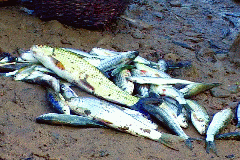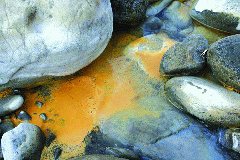Archives
environment

Rat hole mining is the most prevalent system of mining in the area, it involves a miner going deep down into the earth crust to extract coal. This system of mining is both a health hazard for the miners and is equally detrimental to the environment. Coal mine owners seldom take any care of the exhausted mines, these mines are left open and during summer; they overflow with rain water which gets polluted in the process and then makes its way through streams and rivulets to the rivers.
As if coal mining has not already caused enough damage to the rivers, to add more fuel to the fire, limestone mining is going on in full swing in Lumshnong and its adjacent villages. The last river that fell victim to the rampant mining in the Jaintia hills District is the Lukha River which falls under Elaka Narpuh of Lumchnong area.
It was first reported by the people from the area last February 2007 that the river Lukha has changed colour. The crystal clear colour of Lukha River turned bluish. The report also said that there was the mysterious death of fishes in the river Lukha. The river which flows from the Narpuh forest used to be pristine and full of fresh water fishes of every shape and size, but on the fateful 17 February of 2007, the river turned to a watery grave for the fishes and all the aquatic life in the river. It was an eerie sight, throughout the length and breath of the river one could see dead fishes floating on the water surface and some decayed on the river bank.
In response to the hue and cry made by various NGOs, the Government ordered the Meghalaya State Pollution Control Board to conduct a test on the water bodies in the river. A few weeks later the MSPCB came up with a report that the reason for the mysterious death of the fishes in the river Lukha was due to the increase of pH level in the water and also due to the presence of various minerals in the water that are harmful to the aquatic life in the river. After some time the issue died down and summer dawned on the state, river Lukha too returned to its natural colour but only for few months. The water of the monsoon rains that flows from the Narpuh range helps the river to rejuvenate itself but the problem starts at the onset of the winter when the rain stops falling.
 During the first week of January of 2008, people from the area reported that the colour of the water in the river Lukha changed to a bluish colour again, but fortunately or unfortunately there is no more report of the mysterious death of fishes. The author’s worst fear is that there is no more fish left to die. All the fish in the area had died the first time the water of the river changed its colour during the second week of February 2007.
During the first week of January of 2008, people from the area reported that the colour of the water in the river Lukha changed to a bluish colour again, but fortunately or unfortunately there is no more report of the mysterious death of fishes. The author’s worst fear is that there is no more fish left to die. All the fish in the area had died the first time the water of the river changed its colour during the second week of February 2007.
On the 6th of January 2008 the MSPCB again deputed a team, to conduct a test on the water of the river Lukha. The team which comprises of senior engineer of the MSPCB J.H. Nengnong and Balari Majaw, Enviromental Engineer of the Board along with media persons walked to the confluence of the river Lukha and the river Lunar. The test conducted by the experts of the MSPCB confirmed that the water from the river Lunar which flows from the coal mining area like Myndihati, Khliehriat and the Sakhein has polluted the river Lukha. At the confluence of the two rivers one could even see that the colour of the water of the river Lunar is different from that of the Lukha. The difference is obvious even to the naked eye that the de-colourisation of the river Lukha starts from the confluence of these two rivers.
The Jaintia District has lost many of its major rivers, Kupli, Myntdu and now Lukha to name a few, besides that all the tributaries of these rivers which either flow or start from the coal mining areas are polluted to such an extent that water is not fit even for washing. The only remaining rivers in the District free from pollution are the Myntang, the Niriang and the Umngot. If the Government does not act immediately, one’s worst fear is that one day the people in the Jaintia Hills District will have to cry like Samuel Taylor Colridge’s ancient mariners “…water, water everywhere/ but not a drop to drink...”

